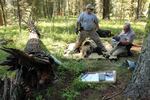It's the deep-bellied growl that stops them.
The researchers are just approaching the grizzly bear when he begins expressing his displeasure. Grizzly No. 1225 had been smart enough to avoid a huge, metal box trap. But not the leg snare next to it.
"Bears are really quick learners. If a bear's been caught, it can be really tricky to catch them again," says Curtis Hendricks, a regional wildlife manager with the Idaho Department of Fish and Game, explaining why his team went with both a snare and a metal trap.
The snare worked. A slim cable attached to the bear's hind leg keeps him a few feet from Hendricks. He fires tranquilizing darts and within minutes the 300-pound bear's growling turns to snoring.
The researchers set to work weighing, measuring and collaring the 4-year-old male.
"Really good body condition. Really good muscle mass on him," Hendricks says. "He's a perfect example of what a young male grizzly should look like in quality habitat. Beautiful bear."
Grizzly No. 1225 spends his summers roaming an area that's also frequented by millions of tourists: The Greater Yellowstone Ecosystem. That's how biologists refer to an area that includes Yellowstone National Park, Grand Teton National Park and portions of Idaho, Montana and Wyoming.
Male grizzly bears will log up to 2,000 miles while criss-crossing their territory between hibernation seasons.
“People don’t really understand how often bears actually move through this area,” Hendricks says. “They don’t want to interact with people. They don’t want garbage per se. But if they find it, then they eat it and that’s where problems come in.”

The grizzly bear population in the Greater Yellowstone Ecosystem grew from less than 200 bears in the 1980s to more than 1,000 today. Ten percent of those bears wear GPS collars.
Kris Millgate
Until the 1970s, Yellowstone National Park officials accommodated bears with garbage-feeding sites. When those dumps closed, bears had to find food on their own, go without or be put down because they posed a safety threat. By 1975, the grizzly population fell below 200 and the bears were declared as threatened under the Endangered Species Act.
Natural recovery is slow when it involves an animal that only produces cubs every few years. But four decades after their "threatened species" designation, there are now more than 1,000 grizzlies and the population is under consideration for removal from the government's list of threatened or endangered species.
Now other regions, including the Pacific Northwest, are taking note.
The federal government is polling the public about recovering the bears in the North Cascades
. That region’s population is smaller than Yellowstone’s in the 1980s and could be as low as a handful.
One recovery option is transplanting bears from elsewhere. Another option is to wait for the grizzly population to expand naturally, similar to the recovery strategy that’s been playing out in the Greater Yellowstone Ecosystem.
Both methods require research to help wildlife managers understand where grizzlies go and what they eat. That’s why 10 percent of the greater Yellowstone bears like Grizzly No. 1225 wear GPS collars. Tracking begins as soon as the collared bear wakes up and leaves the trap.

Curtis Hendricks, Idaho Department of Fish and Game regional wildlife manager, aims a dart gun loaded with a tranquilizer at a 300-pound grizzly bear less than 20 yards away.
Kris Millgate
Researchers like Nichole Walker with the Idaho Department of Fish and Game follow the bear’s GPS waypoints, tracing its route by foot.
“There’s a high level of anxiety sometimes,” Walker says. “But it’s also a big thrill to be out here in bear country and being able to investigate and seeing things a lot of people don’t get to see.”
Walker wants to know why a bear stops where it does, but she doesn’t want the bear to be there when she comes through. She chooses GPS points that are a day old and hollers often to make her presence known. She finds fresh day beds dug behind fallen logs and bark crumbled by bear claws in pursuit of bugs.
“They’re really good generalists as far as being able to make a living on a variety of things,” Hendricks says. “Our research indicates one of the big things they’re eating are ants. Just think of an animal that size sustaining itself on tiny ants.”
Ants, berries, road kill and yes, still today, sometimes garbage. The Greater Yellowstone Coalition is in the middle of a $10 million, multi-year program to help the grizzly bear population thrive in this ecosystem. One of its initiatives is to reduce human-grizzly conflict. The program has helped install bear-proof garbage cans and food storage bins in 103 of the U.S. Forest Service's 164 campgrounds in the region. The rest will be converted by the end of 2017.
“Their population is growing and they are in places that they haven’t been and now it’s to the point to where we have to change some of our behaviors,” says Kathy Rinaldi, Greater Yellowstone Coalition Idaho conservation coordinator. “It’s easy to work with kids. It’s parents or grandparents saying I never used to camp like that. I don’t see the need to do that.”
Hendricks sees the need. Human-bear conflicts are a worry that keeps him up at night. As he attaches a new GPS collar to Grizzly No. 1225, he says he hopes the bear runs into the woods rather than into trouble.
“My whole life grizzlies have been protected,” he says. “To actually see them be on the edge of where they’ve recovered enough to where they don’t need to be listed is a cool thing to be a part of.”